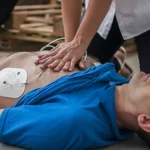The sooner you begin cardiopulmonary resuscitation, the more likely you can prevent brain damage or brain death and save lives. In nearly all cardiac arrest cases, you should continue to perform CPR until professional medical assistance arrives. However, it is also essential to know when you should stop CPR.
How Do I Perform Hands-Only Cardiopulmonary Resuscitation?
Many instructors and medical professionals now believe performing mouth-to-mouth resuscitation is ill-advisable, especially for non-CPR certified bystanders. These professionals recommend calling 911 immediately and beginning chest compressions at a rate of 100 to 120 compressions per minute.
How Do I Perform Cardiopulmonary Resuscitation With Rescue Breaths?
If you are CPR-certified, you should incorporate chest compressions and rescue breaths into your life-saving efforts. Start CPR after calling 911 and perform a cycle of 30 chest compressions. After finishing 30 chest compressions, perform two rescue breaths. Repeat this cycle until medical attention arrives.
Below are the following circumstances when you should stop CPR:
When the patient is showing signs of life.
The primary purpose of conducting CPR is to restart the heart and restore the patient to a normal condition. Once you achieve this aim, there is no reason to continue giving CPR.
When the victim exhibits promising vital signs such as breathing normally or voluntary movements, you should stop. At this point, keep his/her airway open and watch the patient’s breathing pattern closely.
When medical professionals arrive and take over.
If you follow the correct protocol, EMS will arrive shortly after completing your first round of chest compressions and rescue breaths. After medical personnel comes, you should let them take over the life-saving efforts.
EMS professionals have more experience than you, and they will be able to assist the victim better. Help the cardiac arrest victim by letting these professionals provide further care.
When the area becomes unsafe.
There is no sense in having two critically injured people instead of one. If the environment becomes dangerous, you should try to move the victim instead of administering chest compressions. If you try to perform CPR in a hazardous environment, the result will likely cause more harm than good.
Safety is the number one priority in every situation. If the area suddenly becomes dangerous, stop CPR, and take precautions based on the situation.
When the person is feeling exhausted.
If the person performing CPR on the victim becomes tired, they won’t administer chest compressions or rescue breaths correctly. Because of this, they should stop and exchange places with other trained individuals. If there are no other trained individuals present, the exhausted party should instruct an untrained bystander how to take over.
Conclusion- When To Stop Compressions On a Victim
Trained individuals must know in what situation they should stop CPR. Although these may be rare, it is crucial to remember that performing CPR incorrectly can cause more harm than good.
If you follow the correct CPR procedure and immediately call 911, you should only perform CPR for a minimal time. Medical responders should arrive and take over the scene.
If you are not CPR certified, we highly recommend taking the course and learning more to prepare for such emergency cases.
Individuals should receive training on the steps of CPR, and they should be able to answer questions such as “how many compressions for CPR” or “what is hands-only CPR?”
The American Health Care Academy provides online courses that can be taken by just about anyone capable of reading and comprehending. This institution aims to widen a person’s knowledge about emergencies and provide the correct response for them. Remember, these techniques could help save someone’s life. Click the following link to begin your online CPR AED certification today!













